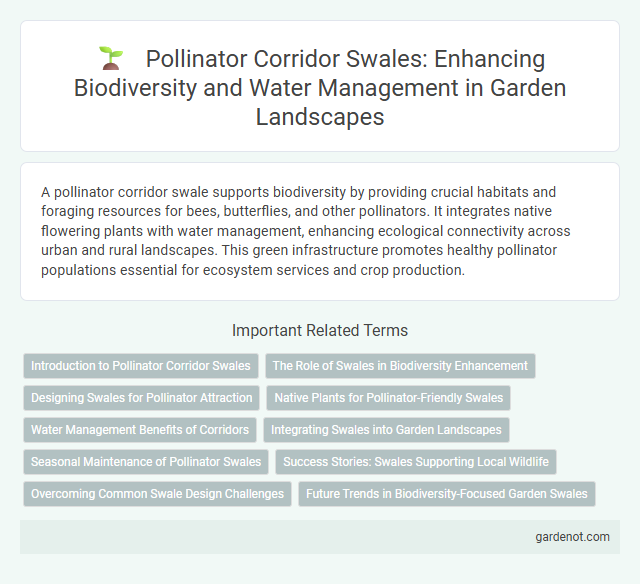A pollinator corridor swale supports biodiversity by providing crucial habitats and foraging resources for bees, butterflies, and other pollinators. It integrates native flowering plants with water management, enhancing ecological connectivity across urban and rural landscapes. This green infrastructure promotes healthy pollinator populations essential for ecosystem services and crop production.
Introduction to Pollinator Corridor Swales
Pollinator corridor swales are engineered landscape features designed to support biodiversity by facilitating the movement of pollinators such as bees, butterflies, and hummingbirds across urban and rural areas. These swales integrate native flowering plants that provide essential nectar and pollen resources, creating continuous habitat connectivity and improving pollination services for surrounding ecosystems and agriculture. Effective pollinator corridor swales contribute to ecosystem resilience by enhancing pollinator population health and promoting sustainable urban drainage management.
The Role of Swales in Biodiversity Enhancement
Pollinator corridor swales serve as vital habitats by connecting fragmented ecosystems, supporting a variety of pollinators such as bees, butterflies, and hummingbirds. These swales promote biodiversity by providing nectar sources, shelter, and breeding grounds, which enhance ecological resilience and ecosystem services. Implementing swales in urban and agricultural landscapes fosters pollinator movement and genetic exchange, crucial for plant reproduction and biodiversity preservation.
Designing Swales for Pollinator Attraction
Designing swales for pollinator attraction involves incorporating a diverse mix of native flowering plants that provide continuous bloom cycles, essential for sustaining local bee species and butterflies. Integrating layered vegetation with varying heights and textures creates optimal habitats and nesting sites, enhancing pollinator activity. Ensuring swales maintain proper moisture levels through strategic grading and soil composition supports the growth of nectar-rich flora vital for pollinator health.
Native Plants for Pollinator-Friendly Swales
Native plants such as milkweed, purple coneflower, and bee balm are essential components of a pollinator-friendly swale, providing critical nectar and pollen sources for bees, butterflies, and hummingbirds. Integrating deep-rooted native grasses like little bluestem or switchgrass enhances soil infiltration while supporting diverse insect habitats. These plant selections improve swale functionality by promoting biodiversity, stabilizing soil, and sustaining native pollinator populations crucial for ecosystem health.
Water Management Benefits of Corridors
Pollinator corridor swales enhance water management by capturing and infiltrating stormwater, reducing runoff and promoting groundwater recharge. These corridors support ecosystem resilience through improved soil moisture retention, which benefits both native vegetation and pollinator habitats. Integrating swales within pollinator corridors contributes to sustainable urban drainage systems and mitigates urban flooding risks effectively.
Integrating Swales into Garden Landscapes
Integrating pollinator corridor swales into garden landscapes enhances biodiversity by creating continuous habitats that support bees, butterflies, and other vital pollinators. These swales efficiently manage stormwater while providing native flowering plants that attract and sustain pollinator populations. Strategic placement of swales alongside pathways and garden beds maximizes ecological connectivity and garden health.
Seasonal Maintenance of Pollinator Swales
Seasonal maintenance of pollinator corridors in swales ensures optimal habitat conditions by managing invasive vegetation, controlling sediment buildup, and enhancing native plant diversity. Regular monitoring during spring and fall promotes flowering plant health, supporting pollinator populations such as bees, butterflies, and hummingbirds. Proper upkeep of pollinator swales improves biodiversity, water infiltration, and ecosystem resilience throughout varying seasonal cycles.
Success Stories: Swales Supporting Local Wildlife
Pollinator corridor swales create essential habitats that increase the biodiversity of local ecosystems, supporting bees, butterflies, and other pollinators by providing continuous foraging paths. Successful implementations in urban areas have demonstrated significant boosts in native pollinator populations and improved plant pollination rates, enhancing local agricultural productivity. These swales also contribute to water conservation and soil health, creating a resilient environment that sustains diverse wildlife communities.
Overcoming Common Swale Design Challenges
Pollinator corridor swales enhance biodiversity by creating continuous habitats that support bees, butterflies, and other pollinators while managing stormwater runoff effectively. Designing these swales requires addressing common challenges such as ensuring appropriate native plant selection, optimizing soil composition for water infiltration, and maintaining connectivity between habitats. Implementing adaptive management techniques and incorporating community involvement helps overcome issues like invasive species encroachment, variable rainfall patterns, and maintenance constraints in pollinator-friendly swale projects.
Future Trends in Biodiversity-Focused Garden Swales
Pollinator corridor swales are emerging as vital components in urban biodiversity strategies, enhancing habitat connectivity for bees, butterflies, and other key pollinators. Future trends highlight the integration of native flowering plants and adaptive green infrastructure technologies to optimize water management and ecological impact. These innovative garden swales contribute to resilient ecosystems by supporting pollinator populations and boosting local biodiversity in increasingly fragmented landscapes.
Pollinator corridor swale Infographic

 gardenot.com
gardenot.com